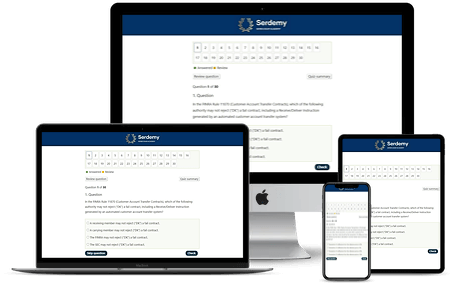Quiz-summary
0 of 30 questions completed
Questions:
- 1
- 2
- 3
- 4
- 5
- 6
- 7
- 8
- 9
- 10
- 11
- 12
- 13
- 14
- 15
- 16
- 17
- 18
- 19
- 20
- 21
- 22
- 23
- 24
- 25
- 26
- 27
- 28
- 29
- 30
Information
Premium Practice Questions
You have already completed the quiz before. Hence you can not start it again.
Quiz is loading...
You must sign in or sign up to start the quiz.
You have to finish following quiz, to start this quiz:
Results
0 of 30 questions answered correctly
Your time:
Time has elapsed
Categories
- Not categorized 0%
- 1
- 2
- 3
- 4
- 5
- 6
- 7
- 8
- 9
- 10
- 11
- 12
- 13
- 14
- 15
- 16
- 17
- 18
- 19
- 20
- 21
- 22
- 23
- 24
- 25
- 26
- 27
- 28
- 29
- 30
- Answered
- Review
-
Question 1 of 30
1. Question
Anika, a registered representative, is preparing a personalized email for Mr. Chen, a prospective client with a high-risk tolerance. The email discusses a new biotech sector fund that is currently in its cooling-off period, with only a preliminary prospectus available. To illustrate the potential for growth, Anika plans to include a performance chart from a well-established, successful technology fund managed by the same fund family. The email will conclude with a link that directs Mr. Chen to a webpage where he can open an account and place a conditional order for the new fund. A principal of the firm reviews the draft. Which of the following best assesses the compliance of this proposed communication?
Correct
The proposed communication is non-compliant for two primary reasons. First, under FINRA Rule 2210, all communications with the public must be fair, balanced, and not misleading. Including a performance chart for a different, established fund, even if it is from the same fund family and has a similar name, creates a misleading impression about the potential performance of the new, unproven fund. Past performance of one fund is not indicative of the future results of another, and using it as a proxy in this manner is a significant violation of the fair and balanced standard. Second, the new fund is still in its pre-effective or cooling-off period, as indicated by the availability of only a preliminary prospectus. During this time, Section 5 of the Securities Act of 1933 strictly prohibits making actual offers to sell or accepting payment for the securities. While soliciting non-binding indications of interest is permissible, including a direct link to open an account and place an order constitutes an illegal offer to sell. The communication moves beyond a permissible tombstone ad or preliminary prospectus delivery into a prohibited sales activity before the security’s registration is declared effective by the SEC.
Incorrect
The proposed communication is non-compliant for two primary reasons. First, under FINRA Rule 2210, all communications with the public must be fair, balanced, and not misleading. Including a performance chart for a different, established fund, even if it is from the same fund family and has a similar name, creates a misleading impression about the potential performance of the new, unproven fund. Past performance of one fund is not indicative of the future results of another, and using it as a proxy in this manner is a significant violation of the fair and balanced standard. Second, the new fund is still in its pre-effective or cooling-off period, as indicated by the availability of only a preliminary prospectus. During this time, Section 5 of the Securities Act of 1933 strictly prohibits making actual offers to sell or accepting payment for the securities. While soliciting non-binding indications of interest is permissible, including a direct link to open an account and place an order constitutes an illegal offer to sell. The communication moves beyond a permissible tombstone ad or preliminary prospectus delivery into a prohibited sales activity before the security’s registration is declared effective by the SEC.
-
Question 2 of 30
2. Question
Leilani recently began the annuitization phase of her non-qualified variable annuity, which has an Assumed Interest Rate (AIR) of 4%. After receiving her first monthly payment, she reviews the performance data. For the period leading up to her first payment, the separate account’s actual net return was exactly 4%. For the period leading up to her second payment, the separate account’s actual net return was 7%. Based on this information, what is the expected relationship of her second payment to her first?
Correct
The determination of the second payment amount is based on the comparison between the separate account’s actual performance and the contract’s Assumed Interest Rate (AIR). The AIR is a benchmark; it is the hypothetical rate of return that, if achieved by the separate account, would result in the annuitant’s monthly payment remaining level. When an individual annuitizes a variable annuity, their accumulation units are converted into a fixed number of annuity units. The value of each annuity unit, however, fluctuates based on the investment performance of the underlying separate account relative to the AIR. The monthly payment is calculated by multiplying the fixed number of annuity units by the current annuity unit value. In the first month, the separate account’s actual net return was exactly equal to the AIR. This means the annuity unit value for that month did not change from its initial value, establishing the amount of the first payment. In the second month, the separate account’s actual net return was significantly higher than the AIR. Because the investment performance exceeded the AIR benchmark, the value of each annuity unit must increase. Consequently, when the fixed number of annuity units is multiplied by this new, higher unit value, the resulting monthly payment for the second month will be greater than the payment received in the first month. The three possible outcomes are: if actual return is greater than AIR, the payment increases; if actual return is equal to AIR, the payment stays the same; if actual return is less than AIR, the payment decreases.
Incorrect
The determination of the second payment amount is based on the comparison between the separate account’s actual performance and the contract’s Assumed Interest Rate (AIR). The AIR is a benchmark; it is the hypothetical rate of return that, if achieved by the separate account, would result in the annuitant’s monthly payment remaining level. When an individual annuitizes a variable annuity, their accumulation units are converted into a fixed number of annuity units. The value of each annuity unit, however, fluctuates based on the investment performance of the underlying separate account relative to the AIR. The monthly payment is calculated by multiplying the fixed number of annuity units by the current annuity unit value. In the first month, the separate account’s actual net return was exactly equal to the AIR. This means the annuity unit value for that month did not change from its initial value, establishing the amount of the first payment. In the second month, the separate account’s actual net return was significantly higher than the AIR. Because the investment performance exceeded the AIR benchmark, the value of each annuity unit must increase. Consequently, when the fixed number of annuity units is multiplied by this new, higher unit value, the resulting monthly payment for the second month will be greater than the payment received in the first month. The three possible outcomes are: if actual return is greater than AIR, the payment increases; if actual return is equal to AIR, the payment stays the same; if actual return is less than AIR, the payment decreases.
-
Question 3 of 30
3. Question
Amara, a registered representative, is preparing several client outreach materials. To comply with FINRA Rule 2210, she is reviewing the approval requirements for each item. Which of the following communications would mandate pre-use approval by a registered principal?
Correct
The core of this issue rests on understanding the classifications of communications with the public under FINRA Rule 2210 and their corresponding approval requirements. FINRA categorizes communications into three types: institutional communication, retail communication, and correspondence. Institutional communication is any written communication distributed or made available only to institutional investors, such as banks, insurance companies, or any entity with total assets of at least $50 million. This type of communication does not require prior principal approval but is subject to the firm’s review and supervision procedures. Correspondence is defined as any written communication distributed or made available to 25 or fewer retail investors within any 30-calendar-day period. Like institutional communication, correspondence is subject to review but does not mandate pre-use approval by a principal. The most stringently regulated category is retail communication, which is any written communication distributed or made available to more than 25 retail investors within any 30-calendar-day period. This category includes advertisements and sales literature. Under FINRA rules, most retail communications must be approved by a registered principal of the firm before the earlier of its use or filing with FINRA’s Advertising Regulation Department. In the described scenario, the brochure intended for more than 25 potential clients clearly falls into the definition of retail communication, thereby triggering the requirement for prior approval by a registered principal. The other communications described are either correspondence or institutional communication, which have less stringent pre-use approval requirements.
Incorrect
The core of this issue rests on understanding the classifications of communications with the public under FINRA Rule 2210 and their corresponding approval requirements. FINRA categorizes communications into three types: institutional communication, retail communication, and correspondence. Institutional communication is any written communication distributed or made available only to institutional investors, such as banks, insurance companies, or any entity with total assets of at least $50 million. This type of communication does not require prior principal approval but is subject to the firm’s review and supervision procedures. Correspondence is defined as any written communication distributed or made available to 25 or fewer retail investors within any 30-calendar-day period. Like institutional communication, correspondence is subject to review but does not mandate pre-use approval by a principal. The most stringently regulated category is retail communication, which is any written communication distributed or made available to more than 25 retail investors within any 30-calendar-day period. This category includes advertisements and sales literature. Under FINRA rules, most retail communications must be approved by a registered principal of the firm before the earlier of its use or filing with FINRA’s Advertising Regulation Department. In the described scenario, the brochure intended for more than 25 potential clients clearly falls into the definition of retail communication, thereby triggering the requirement for prior approval by a registered principal. The other communications described are either correspondence or institutional communication, which have less stringent pre-use approval requirements.
-
Question 4 of 30
4. Question
An internal compliance review at a broker-dealer is examining a draft brochure for a new sector-focused mutual fund. The registered representative who created the draft, Kenji, intended for it to be used as retail communication. The compliance officer has flagged several elements for revision. Which of the following proposed elements represents the most significant and fundamental violation of FINRA Rule 2210’s standards for communications with the public?
Correct
FINRA Rule 2210 governs communications with the public and mandates that all such communications be based on principles of fair dealing and good faith, ensuring they are fair, balanced, and not misleading. A core tenet of this rule is the prohibition of false, exaggerated, unwarranted, promissory, or misleading statements or claims. Using the word “guaranteed” in the context of a mutual fund, which is an investment vehicle subject to market fluctuations and risk of principal loss, is a direct and serious violation. This term implies a level of certainty and safety that cannot be offered for such a product. It misrepresents the fundamental nature of the investment and creates a false sense of security for potential investors. While other issues, such as the presentation of performance data, comparisons, and testimonials, are also strictly regulated to ensure fairness and proper context, making a promissory claim like a guarantee strikes at the heart of investor protection principles. Such a statement is inherently misleading and is considered a significant breach of the duty to provide accurate and balanced information, regardless of any other disclosures that may be present in the material. The other practices, such as cherry-picking performance data or making incomplete comparisons, are also violations, but the use of a guarantee is a foundational misrepresentation of the product’s risk.
Incorrect
FINRA Rule 2210 governs communications with the public and mandates that all such communications be based on principles of fair dealing and good faith, ensuring they are fair, balanced, and not misleading. A core tenet of this rule is the prohibition of false, exaggerated, unwarranted, promissory, or misleading statements or claims. Using the word “guaranteed” in the context of a mutual fund, which is an investment vehicle subject to market fluctuations and risk of principal loss, is a direct and serious violation. This term implies a level of certainty and safety that cannot be offered for such a product. It misrepresents the fundamental nature of the investment and creates a false sense of security for potential investors. While other issues, such as the presentation of performance data, comparisons, and testimonials, are also strictly regulated to ensure fairness and proper context, making a promissory claim like a guarantee strikes at the heart of investor protection principles. Such a statement is inherently misleading and is considered a significant breach of the duty to provide accurate and balanced information, regardless of any other disclosures that may be present in the material. The other practices, such as cherry-picking performance data or making incomplete comparisons, are also violations, but the use of a guarantee is a foundational misrepresentation of the product’s risk.
-
Question 5 of 30
5. Question
An assessment of a registered representative’s planned outreach activities for compliance with FINRA Rule 2210 reveals the following items: 1. A personalized email discussing a recent account transfer for a single, long-standing retail client. 2. A detailed performance analysis report created exclusively for the investment committee of a large corporate pension fund. 3. A standardized email template containing a mutual fund fact sheet, intended to be sent to 35 prospective retail clients. Which of these planned communications would require pre-use approval by a registered principal of the firm?
Correct
FINRA Rule 2210 governs communications with the public and establishes three main categories: correspondence, retail communication, and institutional communication. The classification determines the applicable supervision and approval requirements. Correspondence is defined as any written communication, including electronic, that is distributed or made available to 25 or fewer retail investors within any 30 calendar-day period. Firms must establish written procedures for the review of correspondence, which can be done either before or after use. Retail communication is any written communication, including electronic, distributed or made available to more than 25 retail investors within any 30 calendar-day period. A key distinction is that retail communications generally require pre-approval by a registered principal of the member firm before they are used. The email template intended for 35 prospective clients falls squarely into this category because the number of recipients exceeds the 25-investor threshold. Institutional communication is any written communication distributed or made available only to institutional investors, such as banks, insurance companies, or registered investment companies. The detailed analysis for the corporate pension fund is an example of institutional communication. These communications do not require prior principal approval, but firms must have procedures for supervising them. The personalized email to a single, long-standing client is classified as correspondence and is subject to the firm’s review procedures, not a mandatory pre-use approval. Therefore, only the email template for the 35 prospects constitutes a retail communication that mandates pre-use approval by a registered principal.
Incorrect
FINRA Rule 2210 governs communications with the public and establishes three main categories: correspondence, retail communication, and institutional communication. The classification determines the applicable supervision and approval requirements. Correspondence is defined as any written communication, including electronic, that is distributed or made available to 25 or fewer retail investors within any 30 calendar-day period. Firms must establish written procedures for the review of correspondence, which can be done either before or after use. Retail communication is any written communication, including electronic, distributed or made available to more than 25 retail investors within any 30 calendar-day period. A key distinction is that retail communications generally require pre-approval by a registered principal of the member firm before they are used. The email template intended for 35 prospective clients falls squarely into this category because the number of recipients exceeds the 25-investor threshold. Institutional communication is any written communication distributed or made available only to institutional investors, such as banks, insurance companies, or registered investment companies. The detailed analysis for the corporate pension fund is an example of institutional communication. These communications do not require prior principal approval, but firms must have procedures for supervising them. The personalized email to a single, long-standing client is classified as correspondence and is subject to the firm’s review procedures, not a mandatory pre-use approval. Therefore, only the email template for the 35 prospects constitutes a retail communication that mandates pre-use approval by a registered principal.
-
Question 6 of 30
6. Question
Anya, a registered representative at a FINRA member firm, manages a professional social media profile that is publicly accessible. She intends to create a post discussing the general benefits of diversification using a new family of mutual funds offered by her firm. Her network of followers on this platform includes over 100 individuals, a mix of personal contacts and clients, with at least 40 of them being confirmed retail investors. According to FINRA Rule 2210, what is the proper classification of this intended social media post and what is the required supervisory action before she can publish it?
Correct
Under FINRA Rule 2210, Communications with the Public, communications are categorized into three types: institutional, retail, and correspondence. The classification depends on the audience. Institutional communication is any written or electronic communication distributed or made available only to institutional investors. Correspondence is any written or electronic communication distributed or made available to 25 or fewer retail investors within any 30-calendar-day period. Retail communication is any written or electronic communication that is distributed or made available to more than 25 retail investors within any 30-calendar-day period. A social media post on a publicly accessible platform, where the representative’s network is known to include more than 25 retail investors, is considered retail communication because it is being made available to this audience. The general rule for retail communication is that it must be approved by an appropriately qualified registered principal of the member firm before the earlier of its use or filing with FINRA. This pre-approval requirement is a critical supervisory control to ensure the communication is fair, balanced, and not misleading. Correspondence, by contrast, does not require pre-approval but is subject to the firm’s supervision and review procedures. Institutional communication also has its own set of rules, which are generally less restrictive than those for retail communications. Therefore, the representative’s intended public post falls squarely under the definition of retail communication, necessitating prior principal approval.
Incorrect
Under FINRA Rule 2210, Communications with the Public, communications are categorized into three types: institutional, retail, and correspondence. The classification depends on the audience. Institutional communication is any written or electronic communication distributed or made available only to institutional investors. Correspondence is any written or electronic communication distributed or made available to 25 or fewer retail investors within any 30-calendar-day period. Retail communication is any written or electronic communication that is distributed or made available to more than 25 retail investors within any 30-calendar-day period. A social media post on a publicly accessible platform, where the representative’s network is known to include more than 25 retail investors, is considered retail communication because it is being made available to this audience. The general rule for retail communication is that it must be approved by an appropriately qualified registered principal of the member firm before the earlier of its use or filing with FINRA. This pre-approval requirement is a critical supervisory control to ensure the communication is fair, balanced, and not misleading. Correspondence, by contrast, does not require pre-approval but is subject to the firm’s supervision and review procedures. Institutional communication also has its own set of rules, which are generally less restrictive than those for retail communications. Therefore, the representative’s intended public post falls squarely under the definition of retail communication, necessitating prior principal approval.
-
Question 7 of 30
7. Question
Anika, a registered representative, is tasked with reviewing a new retail communication piece for the “Global Technology Leaders Fund.” The fund’s prospectus discloses a non-fundamental policy to invest, under normal circumstances, at least 80% of its net assets in equity securities of technology companies, in accordance with the Investment Company Act of 1940’s “Names Rule.” Due to severe recent market volatility in the technology sector, the portfolio manager has, for defensive purposes, temporarily reallocated assets. The fund’s current composition is 70% technology securities and 30% short-term government debt. The new retail communication prominently features the fund’s name and its long-term objectives but makes no mention of the current defensive posture. What is the primary compliance issue Anika must escalate to her supervisor regarding this communication?
Correct
The core issue revolves around the Investment Company Act of 1940, specifically Section 35d-1, commonly known as the “Names Rule.” This rule requires a registered investment company with a name suggesting a focus on a particular type of investment, industry, or geographic area to adopt a policy to invest at least 80% of its assets in that type of investment. The rule does permit temporary departures from this 80% policy for defensive purposes, such as in response to adverse market or economic conditions. However, this flexibility does not provide a blanket exemption from other regulations concerning communications with the public. FINRA Rule 2210 and Section 34b-1 of the Investment Company Act of 1940 prohibit the use of any communication that is misleading or omits material facts. When a fund’s name implies a specific investment strategy, the name itself is a key piece of marketing. If the fund has temporarily and significantly deviated from that strategy, even for legitimate defensive reasons, continuing to prominently use that name in new retail communications without any clarification or additional context could be considered materially misleading. An investor might reasonably assume from the name “Global Technology Leaders Fund” that they are buying into a portfolio that is, at that moment, heavily concentrated in technology stocks. The fact that the fund is currently holding only 70% in tech securities is a material fact that an investor should know. The primary compliance concern is not the deviation itself, which may be permissible, but the potential for the marketing material to create a false impression of the fund’s current holdings and risk profile.
Incorrect
The core issue revolves around the Investment Company Act of 1940, specifically Section 35d-1, commonly known as the “Names Rule.” This rule requires a registered investment company with a name suggesting a focus on a particular type of investment, industry, or geographic area to adopt a policy to invest at least 80% of its assets in that type of investment. The rule does permit temporary departures from this 80% policy for defensive purposes, such as in response to adverse market or economic conditions. However, this flexibility does not provide a blanket exemption from other regulations concerning communications with the public. FINRA Rule 2210 and Section 34b-1 of the Investment Company Act of 1940 prohibit the use of any communication that is misleading or omits material facts. When a fund’s name implies a specific investment strategy, the name itself is a key piece of marketing. If the fund has temporarily and significantly deviated from that strategy, even for legitimate defensive reasons, continuing to prominently use that name in new retail communications without any clarification or additional context could be considered materially misleading. An investor might reasonably assume from the name “Global Technology Leaders Fund” that they are buying into a portfolio that is, at that moment, heavily concentrated in technology stocks. The fact that the fund is currently holding only 70% in tech securities is a material fact that an investor should know. The primary compliance concern is not the deviation itself, which may be permissible, but the potential for the marketing material to create a false impression of the fund’s current holdings and risk profile.
-
Question 8 of 30
8. Question
An assessment of the “Global Sustainable Agriculture Fund,” a registered open-end management investment company, is being conducted by a firm’s compliance department. To avoid misleading investors, the fund’s name must accurately reflect its investment portfolio according to SEC Rule 35d-1. Which of the following portfolio compositions would most likely constitute a violation of this “Names Rule”?
Correct
The solution is determined by applying the Investment Company Act of 1940’s Rule 35d-1, commonly known as the “Names Rule.” This rule is designed to prevent investment companies from using names that could mislead investors about the fund’s investments and risks. The rule states that if a fund’s name suggests a focus on a particular type of investment, industry, or geographic area, the fund must adopt a policy to invest, under normal circumstances, at least 80% of its assets in the type of investment suggested by its name. The term “assets” is defined as net assets plus the amount of any borrowings for investment purposes. In the given scenario, the fund is named the “Global Sustainable Agriculture Fund.” This name clearly implies a focus on investments related to sustainable agriculture. Therefore, to comply with Rule 35d-1, the fund must have a policy to invest at least 80% of its assets in securities related to sustainable agriculture. We must evaluate the portfolio composition provided. The portfolio consists of 60% in stocks of organic farming companies and 15% in bonds of companies specializing in water conservation technology for agriculture. Both of these components fall under the umbrella of “sustainable agriculture.” The sum of these investments is 60% + 15% = 75%. The remaining 25% is held in a diversified technology sector ETF, which does not align with the fund’s stated investment focus. Since the total investment in securities related to sustainable agriculture is 75%, this falls short of the 80% threshold required by Rule 35d-1. This discrepancy between the fund’s name and its actual investment holdings constitutes a violation of the rule. The purpose of the rule is to ensure that an investor who selects a fund based on its name receives an investment that is true to that name’s implied strategy.
Incorrect
The solution is determined by applying the Investment Company Act of 1940’s Rule 35d-1, commonly known as the “Names Rule.” This rule is designed to prevent investment companies from using names that could mislead investors about the fund’s investments and risks. The rule states that if a fund’s name suggests a focus on a particular type of investment, industry, or geographic area, the fund must adopt a policy to invest, under normal circumstances, at least 80% of its assets in the type of investment suggested by its name. The term “assets” is defined as net assets plus the amount of any borrowings for investment purposes. In the given scenario, the fund is named the “Global Sustainable Agriculture Fund.” This name clearly implies a focus on investments related to sustainable agriculture. Therefore, to comply with Rule 35d-1, the fund must have a policy to invest at least 80% of its assets in securities related to sustainable agriculture. We must evaluate the portfolio composition provided. The portfolio consists of 60% in stocks of organic farming companies and 15% in bonds of companies specializing in water conservation technology for agriculture. Both of these components fall under the umbrella of “sustainable agriculture.” The sum of these investments is 60% + 15% = 75%. The remaining 25% is held in a diversified technology sector ETF, which does not align with the fund’s stated investment focus. Since the total investment in securities related to sustainable agriculture is 75%, this falls short of the 80% threshold required by Rule 35d-1. This discrepancy between the fund’s name and its actual investment holdings constitutes a violation of the rule. The purpose of the rule is to ensure that an investor who selects a fund based on its name receives an investment that is true to that name’s implied strategy.
-
Question 9 of 30
9. Question
Mateo, a registered representative at a FINRA member firm, is creating a marketing campaign for a new variable annuity. His plan includes a PowerPoint presentation for a seminar with 40 retail prospects, a one-page flyer to be mailed to 100 households, a script for a video to be posted on the firm’s public website, and a personalized email template for 15 of his established clients. Based on FINRA Rule 2210, which statement accurately describes the required supervisory actions for these materials?
Correct
This scenario requires an analysis of communication types under FINRA Rule 2210. The rule defines three categories: institutional, retail, and correspondence. Retail communication is any written communication, including electronic, that is distributed or made available to more than 25 retail investors within any 30 calendar-day period. Correspondence is any written communication, including electronic, that is distributed or made available to 25 or fewer retail investors within any 30 calendar-day period. Institutional communication is any written communication distributed or made available only to institutional investors. In this case, the PowerPoint presentation for the seminar with 40 prospective clients and the flyer mailed to 100 potential clients both target more than 25 retail investors. Therefore, they are classified as retail communications. The script for the video to be posted on the firm’s public website is also retail communication because it is broadly accessible to the public. Under FINRA Rule 2210, retail communications must be reviewed and approved by an appropriately qualified registered principal of the member firm before the earlier of its use or filing with FINRA’s Advertising Regulation Department. The personalized email template, however, is intended for only 15 existing clients. Since this number is 25 or fewer, the email is classified as correspondence. Correspondence is not required to be pre-approved by a principal. Instead, it is subject to the firm’s general supervision and review procedures, which can be conducted either before or after the communication is sent, depending on the firm’s policies. Therefore, the presentation, flyer, and video script require principal pre-approval, while the email is subject to the firm’s correspondence review procedures.
Incorrect
This scenario requires an analysis of communication types under FINRA Rule 2210. The rule defines three categories: institutional, retail, and correspondence. Retail communication is any written communication, including electronic, that is distributed or made available to more than 25 retail investors within any 30 calendar-day period. Correspondence is any written communication, including electronic, that is distributed or made available to 25 or fewer retail investors within any 30 calendar-day period. Institutional communication is any written communication distributed or made available only to institutional investors. In this case, the PowerPoint presentation for the seminar with 40 prospective clients and the flyer mailed to 100 potential clients both target more than 25 retail investors. Therefore, they are classified as retail communications. The script for the video to be posted on the firm’s public website is also retail communication because it is broadly accessible to the public. Under FINRA Rule 2210, retail communications must be reviewed and approved by an appropriately qualified registered principal of the member firm before the earlier of its use or filing with FINRA’s Advertising Regulation Department. The personalized email template, however, is intended for only 15 existing clients. Since this number is 25 or fewer, the email is classified as correspondence. Correspondence is not required to be pre-approved by a principal. Instead, it is subject to the firm’s general supervision and review procedures, which can be conducted either before or after the communication is sent, depending on the firm’s policies. Therefore, the presentation, flyer, and video script require principal pre-approval, while the email is subject to the firm’s correspondence review procedures.
-
Question 10 of 30
10. Question
An assessment of a proposed retail communication for the “Apex U.S. Government Bond Fund” is being conducted by a principal. The communication is a widely distributed email highlighting the fund’s objective of providing income and capital preservation. Given the fund’s name and the nature of the communication, which of the following is a critical compliance requirement under FINRA and SEC rules?
Correct
The logical determination for the required disclosure is as follows: 1. The communication is defined as retail communication under FINRA Rule 2210 because it is intended for more than 25 retail investors. 2. The fund’s name, “Apex U.S. Government Bond Fund,” triggers the Investment Company Act of 1940 Rule 35d-1, the “Names Rule.” This rule requires a fund with a name suggesting a specific investment type to invest at least 80% of its assets in that type of investment. 3. More importantly, a name that includes terms like “Government” or “Guaranteed” can be misleading to investors, suggesting that the fund shares themselves are backed by the full faith and credit of the U.S. government. 4. FINRA Rule 2210 requires all communications to be fair, balanced, and not misleading. To counteract the potentially misleading nature of the fund’s name, a specific, prominent disclosure is required. 5. This disclosure must clarify the distinction between the underlying securities and the fund shares. While the U.S. government securities held by the fund may have guarantees, the shares of the mutual fund itself are not guaranteed or insured by the U.S. government or any of its agencies. 6. Therefore, the communication must explicitly state that the fund’s shares are subject to investment risk, including fluctuation in value and the possible loss of the principal amount invested. This ensures the communication is not misleading about the safety of the investment. A registered representative is reviewing a draft of a retail communication for a mutual fund. The fund’s name can significantly influence an investor’s perception of its strategy and risk level. Under the Investment Company Act of 1940, Rule 35d-1, often called the “Names Rule,” a fund with a name that suggests a focus on a particular type of investment must adopt a policy to invest at least 80% of its assets in those investments. When a fund’s name includes terms that imply safety or a guarantee, such as “U.S. Government,” there is a heightened risk that investors might be misled. They might incorrectly assume that their investment in the fund’s shares is guaranteed by the U.S. government. To comply with FINRA Rule 2210, which mandates that all communications with the public be fair, balanced, and not misleading, firms must include specific clarifying language. The communication must make it clear that while the fund invests in securities that may be backed by the U.S. government, the shares of the fund itself are not insured or guaranteed. The communication must also disclose that the investment is subject to risk, including the potential for loss of principal, and that the share price will fluctuate with market conditions.
Incorrect
The logical determination for the required disclosure is as follows: 1. The communication is defined as retail communication under FINRA Rule 2210 because it is intended for more than 25 retail investors. 2. The fund’s name, “Apex U.S. Government Bond Fund,” triggers the Investment Company Act of 1940 Rule 35d-1, the “Names Rule.” This rule requires a fund with a name suggesting a specific investment type to invest at least 80% of its assets in that type of investment. 3. More importantly, a name that includes terms like “Government” or “Guaranteed” can be misleading to investors, suggesting that the fund shares themselves are backed by the full faith and credit of the U.S. government. 4. FINRA Rule 2210 requires all communications to be fair, balanced, and not misleading. To counteract the potentially misleading nature of the fund’s name, a specific, prominent disclosure is required. 5. This disclosure must clarify the distinction between the underlying securities and the fund shares. While the U.S. government securities held by the fund may have guarantees, the shares of the mutual fund itself are not guaranteed or insured by the U.S. government or any of its agencies. 6. Therefore, the communication must explicitly state that the fund’s shares are subject to investment risk, including fluctuation in value and the possible loss of the principal amount invested. This ensures the communication is not misleading about the safety of the investment. A registered representative is reviewing a draft of a retail communication for a mutual fund. The fund’s name can significantly influence an investor’s perception of its strategy and risk level. Under the Investment Company Act of 1940, Rule 35d-1, often called the “Names Rule,” a fund with a name that suggests a focus on a particular type of investment must adopt a policy to invest at least 80% of its assets in those investments. When a fund’s name includes terms that imply safety or a guarantee, such as “U.S. Government,” there is a heightened risk that investors might be misled. They might incorrectly assume that their investment in the fund’s shares is guaranteed by the U.S. government. To comply with FINRA Rule 2210, which mandates that all communications with the public be fair, balanced, and not misleading, firms must include specific clarifying language. The communication must make it clear that while the fund invests in securities that may be backed by the U.S. government, the shares of the fund itself are not insured or guaranteed. The communication must also disclose that the investment is subject to risk, including the potential for loss of principal, and that the share price will fluctuate with market conditions.
-
Question 11 of 30
11. Question
The following case demonstrates a common client scenario involving mutual fund purchases. Kenji informs his registered representative that he plans to invest a total of $100,000 into the “Navigator Equity Fund” to take advantage of a reduced sales charge at that investment level. However, he can only invest $40,000 today and intends to invest the remaining $60,000 over the next 10 months. According to FINRA rules regarding sales practices, which action is required of the representative to ensure Kenji can benefit from the anticipated breakpoint?
Correct
This scenario involves the proper application of mutual fund sales charge breakpoints. Breakpoints are volume discounts on front-end sales loads, meaning the percentage charge decreases as the investment amount increases. FINRA rules require representatives to inform clients of any available breakpoints and to not recommend sales just below a breakpoint to generate higher commissions. For a client who intends to invest a sum large enough to qualify for a breakpoint over a period of time, the appropriate tool is a Letter of Intent (LOI). An LOI is a non-binding agreement signed by the investor stating their intention to invest the required amount over a specific period, typically 13 months. By signing the LOI, the investor is immediately entitled to the lower sales charge applicable to the total intended investment amount, starting with their very first purchase. To protect the fund distributor, a portion of the investor’s initial shares are held in escrow by the fund’s custodian. If the investor fulfills the LOI by investing the full amount within the 13-month period, the escrowed shares are released to them. If the investor fails to meet the commitment, the escrowed shares are liquidated to pay the difference between the lower sales charge they received and the higher sales charge they should have paid on the amount actually invested. An LOI can also be backdated by up to 90 days to include recent purchases toward the total. This differs from Rights of Accumulation (ROA), which allows existing holdings to be combined with new investments to qualify for a breakpoint on the new money only, without retroactively reducing charges on prior purchases.
Incorrect
This scenario involves the proper application of mutual fund sales charge breakpoints. Breakpoints are volume discounts on front-end sales loads, meaning the percentage charge decreases as the investment amount increases. FINRA rules require representatives to inform clients of any available breakpoints and to not recommend sales just below a breakpoint to generate higher commissions. For a client who intends to invest a sum large enough to qualify for a breakpoint over a period of time, the appropriate tool is a Letter of Intent (LOI). An LOI is a non-binding agreement signed by the investor stating their intention to invest the required amount over a specific period, typically 13 months. By signing the LOI, the investor is immediately entitled to the lower sales charge applicable to the total intended investment amount, starting with their very first purchase. To protect the fund distributor, a portion of the investor’s initial shares are held in escrow by the fund’s custodian. If the investor fulfills the LOI by investing the full amount within the 13-month period, the escrowed shares are released to them. If the investor fails to meet the commitment, the escrowed shares are liquidated to pay the difference between the lower sales charge they received and the higher sales charge they should have paid on the amount actually invested. An LOI can also be backdated by up to 90 days to include recent purchases toward the total. This differs from Rights of Accumulation (ROA), which allows existing holdings to be combined with new investments to qualify for a breakpoint on the new money only, without retroactively reducing charges on prior purchases.
-
Question 12 of 30
12. Question
Lin, a registered representative, creates a new blog post for her firm’s website to be viewed by the general public. The post, which qualifies as retail communication, discusses the “Odyssey International Equity Fund.” It features a prominent line chart showing the fund’s cumulative total return of 45% over the last three years. Directly beneath the chart, a caption reads: “Past performance is not a guarantee of future results. To obtain a prospectus containing the fund’s objectives, risks, charges, and expenses, please contact our office.” The post also includes a generally optimistic outlook on the international market. Which aspect of this blog post represents the most significant violation of rules governing communications with the public?
Correct
Under FINRA Rule 2210, all retail communications must be fair, balanced, and not misleading. This general standard is further detailed by specific SEC rules when advertising investment companies. SEC Rule 482 permits advertisements that omit the detailed information found in a statutory prospectus, but it imposes strict conditions, especially concerning the presentation of performance data. If an investment company advertisement includes performance figures, it must present standardized average annual total returns for one, five, and ten year periods, or for the life of the fund if shorter. This data must be current to the most recent practicable date. Furthermore, the advertisement must clearly state that the performance data quoted represents past performance, that past performance does not guarantee future results, that the investment return and principal value will fluctuate, and that an investment, when redeemed, may be worth more or less than its original cost. Crucially, the communication must also disclose whether a sales load or other nonrecurring fee is charged and, if performance data does not reflect the deduction of the sales load, it must be accompanied by performance figures that do. A simple, non-standardized chart showing total return over a custom period, even with a basic disclaimer, is considered misleading because it can obscure the impact of fees and volatility and fails to provide the comparable, standardized data required for an investor to make an informed judgment. The legend for obtaining a prospectus is also required, but the content of the advertisement itself must not be inherently misleading.
Incorrect
Under FINRA Rule 2210, all retail communications must be fair, balanced, and not misleading. This general standard is further detailed by specific SEC rules when advertising investment companies. SEC Rule 482 permits advertisements that omit the detailed information found in a statutory prospectus, but it imposes strict conditions, especially concerning the presentation of performance data. If an investment company advertisement includes performance figures, it must present standardized average annual total returns for one, five, and ten year periods, or for the life of the fund if shorter. This data must be current to the most recent practicable date. Furthermore, the advertisement must clearly state that the performance data quoted represents past performance, that past performance does not guarantee future results, that the investment return and principal value will fluctuate, and that an investment, when redeemed, may be worth more or less than its original cost. Crucially, the communication must also disclose whether a sales load or other nonrecurring fee is charged and, if performance data does not reflect the deduction of the sales load, it must be accompanied by performance figures that do. A simple, non-standardized chart showing total return over a custom period, even with a basic disclaimer, is considered misleading because it can obscure the impact of fees and volatility and fails to provide the comparable, standardized data required for an investor to make an informed judgment. The legend for obtaining a prospectus is also required, but the content of the advertisement itself must not be inherently misleading.
-
Question 13 of 30
13. Question
Kenji, age 52, purchased a non-qualified deferred variable annuity ten years ago with a single premium payment of $100,000. The contract’s value has since grown to $150,000. He now needs to take a partial surrender of $30,000 for a personal expense but does not want to annuitize the contract. What is the immediate federal income tax consequence of Kenji’s $30,000 withdrawal?
Correct
Initial Investment (Cost Basis) = $100,000 Current Contract Value = $150,000 Total Earnings = Current Value – Cost Basis = $150,000 – $100,000 = $50,000 Partial Withdrawal Amount = $30,000 The tax treatment for withdrawals from a non-qualified deferred annuity follows the Last-In, First-Out (LIFO) method. This means that any earnings within the contract are considered to be withdrawn first, before any of the original investment principal (cost basis). In this scenario, the total earnings are $50,000. The investor is withdrawing $30,000. Since the withdrawal amount is less than the total earnings, the entire $30,000 is considered a distribution of earnings. Taxable Amount = $30,000 The taxable portion is taxed at the investor’s ordinary income tax rate, not as capital gains. After the withdrawal: Remaining Contract Value = $150,000 – $30,000 = $120,000 Remaining Cost Basis = $100,000 (unchanged) Remaining Earnings = $50,000 – $30,000 = $20,000 The tax rules for non-qualified annuities stipulate that all gains are withdrawn before the non-taxable cost basis. This LIFO treatment is a critical concept for representatives to understand when discussing potential withdrawals with clients. It differs significantly from the tax treatment of other investment vehicles and from the exclusion ratio method used once the annuity is annuitized. Furthermore, because the investor is under age 59 and a half, the taxable portion of the withdrawal would typically also be subject to a 10 percent federal tax penalty, in addition to being taxed as ordinary income. The fundamental principle is that earnings are always distributed first during the accumulation phase for any non-annuitized withdrawals. This ensures that the tax-deferred growth is taxed before the owner can access their original investment tax-free.
Incorrect
Initial Investment (Cost Basis) = $100,000 Current Contract Value = $150,000 Total Earnings = Current Value – Cost Basis = $150,000 – $100,000 = $50,000 Partial Withdrawal Amount = $30,000 The tax treatment for withdrawals from a non-qualified deferred annuity follows the Last-In, First-Out (LIFO) method. This means that any earnings within the contract are considered to be withdrawn first, before any of the original investment principal (cost basis). In this scenario, the total earnings are $50,000. The investor is withdrawing $30,000. Since the withdrawal amount is less than the total earnings, the entire $30,000 is considered a distribution of earnings. Taxable Amount = $30,000 The taxable portion is taxed at the investor’s ordinary income tax rate, not as capital gains. After the withdrawal: Remaining Contract Value = $150,000 – $30,000 = $120,000 Remaining Cost Basis = $100,000 (unchanged) Remaining Earnings = $50,000 – $30,000 = $20,000 The tax rules for non-qualified annuities stipulate that all gains are withdrawn before the non-taxable cost basis. This LIFO treatment is a critical concept for representatives to understand when discussing potential withdrawals with clients. It differs significantly from the tax treatment of other investment vehicles and from the exclusion ratio method used once the annuity is annuitized. Furthermore, because the investor is under age 59 and a half, the taxable portion of the withdrawal would typically also be subject to a 10 percent federal tax penalty, in addition to being taxed as ordinary income. The fundamental principle is that earnings are always distributed first during the accumulation phase for any non-annuitized withdrawals. This ensures that the tax-deferred growth is taxed before the owner can access their original investment tax-free.
-
Question 14 of 30
14. Question
Anya, a Series 6 representative at a FINRA member firm, is preparing for a public seminar on long-term retirement strategies, focusing on the roles of mutual funds and variable annuities. She has created a detailed PowerPoint presentation and a separate one-page summary handout to be distributed to all attendees. The seminar has been advertised in the local community, and she anticipates an audience of approximately 50 retail investors. According to FINRA Rule 2210, which statement most accurately describes the supervisory and approval requirements for Anya’s seminar materials?
Correct
Under FINRA Rule 2210, Communications with the Public, materials are categorized based on the audience and number of recipients. Retail communication is defined as any written communication, including electronic, that is distributed or made available to more than 25 retail investors within any 30 calendar day period. This category includes materials like advertisements, sales literature, and presentations intended for a public audience. A key requirement for retail communication is that it must be reviewed and approved by an appropriately qualified registered principal of the member firm before it is used or distributed. In the given scenario, both the PowerPoint presentation and the one-page handout are prepared, written materials. Since they are intended for distribution at a seminar with more than 25 attendees, they squarely fit the definition of retail communication. Therefore, both documents are subject to the pre-approval requirement. The oral presentation itself is considered a public appearance. While the script for a public appearance is considered retail communication and requires pre-approval, the spontaneous or unscripted portions are subject to the firm’s general supervisory procedures, which may include training and surveillance, but not pre-approval of every word spoken. However, the static, prepared materials distributed at the event are not exempt from the rules governing retail communication simply because they are used in the context of a public appearance.
Incorrect
Under FINRA Rule 2210, Communications with the Public, materials are categorized based on the audience and number of recipients. Retail communication is defined as any written communication, including electronic, that is distributed or made available to more than 25 retail investors within any 30 calendar day period. This category includes materials like advertisements, sales literature, and presentations intended for a public audience. A key requirement for retail communication is that it must be reviewed and approved by an appropriately qualified registered principal of the member firm before it is used or distributed. In the given scenario, both the PowerPoint presentation and the one-page handout are prepared, written materials. Since they are intended for distribution at a seminar with more than 25 attendees, they squarely fit the definition of retail communication. Therefore, both documents are subject to the pre-approval requirement. The oral presentation itself is considered a public appearance. While the script for a public appearance is considered retail communication and requires pre-approval, the spontaneous or unscripted portions are subject to the firm’s general supervisory procedures, which may include training and surveillance, but not pre-approval of every word spoken. However, the static, prepared materials distributed at the event are not exempt from the rules governing retail communication simply because they are used in the context of a public appearance.
-
Question 15 of 30
15. Question
A new open-end investment company, the “Helios Solar Energy Fund,” has filed a registration statement with the SEC, but it is not yet effective. Lin, a registered representative, drafts a standalone email to be sent to a list of prospective clients. The email identifies the fund by name, describes it as a “sector fund focused on renewable energy,” and includes the statement: “A prospectus containing more complete information, including all charges and expenses, is available from our firm and should be read carefully before investing.” The email concludes with a hyperlink that directs the recipient to a webpage where they can immediately fill out an application to purchase shares of the fund. From a regulatory perspective, what is the primary compliance failure of Lin’s email?
Correct
The communication in question is being sent after a registration statement has been filed but before it is effective. This period is known as the cooling-off period. During this time, communications with the public are strictly regulated to avoid illegal offers to sell a security. SEC Rule 134, “Communications Not Deemed a Prospectus,” provides a safe harbor for firms to issue certain notices, often called tombstone advertisements, to generate indications of interest from the public. Rule 134 explicitly outlines what information is permissible in such a communication. It allows for the name of the issuer, the title of the security, a brief description of the business, and information on how to obtain a prospectus. However, the rule is very clear about what is prohibited. Specifically, Rule 134(d) states that while the communication may include a means for the recipient to request a prospectus, it cannot include an application or form that could be used to purchase the security. By including a direct link to a webpage with an application to purchase shares, the email goes beyond the scope of a Rule 134 notice. It becomes an illegal offer to sell the security, as defined under Section 5 of the Securities Act of 1933. Section 5 prohibits the sale or offer to sell securities before the registration statement has become effective. Therefore, the most significant compliance failure is the inclusion of the means to apply for purchase, which transforms a permissible notice into a prohibited offer. While other aspects of an advertisement, such as legends or filing requirements, are important, they are secondary to the fundamental violation of making an illegal offer during the cooling-off period.
Incorrect
The communication in question is being sent after a registration statement has been filed but before it is effective. This period is known as the cooling-off period. During this time, communications with the public are strictly regulated to avoid illegal offers to sell a security. SEC Rule 134, “Communications Not Deemed a Prospectus,” provides a safe harbor for firms to issue certain notices, often called tombstone advertisements, to generate indications of interest from the public. Rule 134 explicitly outlines what information is permissible in such a communication. It allows for the name of the issuer, the title of the security, a brief description of the business, and information on how to obtain a prospectus. However, the rule is very clear about what is prohibited. Specifically, Rule 134(d) states that while the communication may include a means for the recipient to request a prospectus, it cannot include an application or form that could be used to purchase the security. By including a direct link to a webpage with an application to purchase shares, the email goes beyond the scope of a Rule 134 notice. It becomes an illegal offer to sell the security, as defined under Section 5 of the Securities Act of 1933. Section 5 prohibits the sale or offer to sell securities before the registration statement has become effective. Therefore, the most significant compliance failure is the inclusion of the means to apply for purchase, which transforms a permissible notice into a prohibited offer. While other aspects of an advertisement, such as legends or filing requirements, are important, they are secondary to the fundamental violation of making an illegal offer during the cooling-off period.
-
Question 16 of 30
16. Question
Kenji, a registered representative at a well-established broker-dealer, is preparing a new marketing initiative. He intends to use an automated system to send an email to a curated list of 40 prospective retail clients. The email, which promotes a specific family of mutual funds, uses a firm-approved template but is personalized with each recipient’s name and city. Assessment of Kenji’s proposed marketing plan under FINRA Rule 2210 reveals which of the following supervisory obligations must be met before he can launch the email campaign?
Correct
This scenario is governed by FINRA Rule 2210, which defines and sets approval requirements for communications with the public. The primary determinant for classifying a communication as either correspondence or retail communication is the number of recipients. Correspondence is defined as any written or electronic communication that is distributed or made available to 25 or fewer retail investors within any 30-calendar-day period. Retail communication is defined as any written or electronic communication that is distributed or made available to more than 25 retail investors within any 30-calendar-day period. In this case, the representative plans to send the email to 40 prospective clients. Since 40 is greater than 25, this communication is classified as a retail communication. The personalization of the email or the use of a pre-approved template does not change this classification, which is based solely on the number of recipients. According to FINRA Rule 2210, retail communications must generally be reviewed and approved by an appropriately qualified registered principal of the member firm before the earlier of its use or filing with FINRA’s Advertising Regulation Department. Therefore, even though a template was used, the final version of the communication intended for the 40 prospects must undergo pre-use approval by a registered principal. The firm’s internal procedures must ensure this review and approval process is completed before the emails are sent.
Incorrect
This scenario is governed by FINRA Rule 2210, which defines and sets approval requirements for communications with the public. The primary determinant for classifying a communication as either correspondence or retail communication is the number of recipients. Correspondence is defined as any written or electronic communication that is distributed or made available to 25 or fewer retail investors within any 30-calendar-day period. Retail communication is defined as any written or electronic communication that is distributed or made available to more than 25 retail investors within any 30-calendar-day period. In this case, the representative plans to send the email to 40 prospective clients. Since 40 is greater than 25, this communication is classified as a retail communication. The personalization of the email or the use of a pre-approved template does not change this classification, which is based solely on the number of recipients. According to FINRA Rule 2210, retail communications must generally be reviewed and approved by an appropriately qualified registered principal of the member firm before the earlier of its use or filing with FINRA’s Advertising Regulation Department. Therefore, even though a template was used, the final version of the communication intended for the 40 prospects must undergo pre-use approval by a registered principal. The firm’s internal procedures must ensure this review and approval process is completed before the emails are sent.
-
Question 17 of 30
17. Question
Anya, a registered representative, is creating a single presentation slide for a public seminar on retirement planning. The slide, which will be subject to principal approval as retail communication, contains the following information for a specific variable annuity separate account: – Headline: The Apex Growth Separate Account – Prominent Graphic: “Ranked #1 for 5-Year Performance in its category by ‘Global Fund Analytics’.” – Key Feature: “Enjoy Tax-Deferred Growth!” – Disclosure: “Past performance is not indicative of future results. The investment return and principal value of an investment will fluctuate.” According to FINRA rules governing communications with the public, which critical element must be added to this slide to ensure compliance?
Correct
The proposed presentation slide is non-compliant with FINRA rules, specifically FINRA Rule 2212, which governs the use of investment company rankings in retail communications. While the slide includes the name of the ranking entity and the time period, it omits a critical piece of context required for the ranking not to be misleading. The rule mandates that any retail communication using a ranking must disclose the total number of investment companies in the category that is being ranked. Stating a fund is ranked number one is potentially misleading if the client does not know if it was ranked number one out of five funds or number one out of five hundred funds. The context provided by the total number of funds in the category is essential for an investor to properly evaluate the significance of the ranking. Furthermore, FINRA Rule 2210 requires all communications to be fair, balanced, and not misleading. Omitting the size of the comparison group violates this principle. While other disclosures are important for variable annuity advertisements, such as the material tax penalties for early withdrawal and the charges and expenses, the direct violation related to the prominent ranking claim is the missing category size. The slide must also include the criteria on which the ranking is based.
Incorrect
The proposed presentation slide is non-compliant with FINRA rules, specifically FINRA Rule 2212, which governs the use of investment company rankings in retail communications. While the slide includes the name of the ranking entity and the time period, it omits a critical piece of context required for the ranking not to be misleading. The rule mandates that any retail communication using a ranking must disclose the total number of investment companies in the category that is being ranked. Stating a fund is ranked number one is potentially misleading if the client does not know if it was ranked number one out of five funds or number one out of five hundred funds. The context provided by the total number of funds in the category is essential for an investor to properly evaluate the significance of the ranking. Furthermore, FINRA Rule 2210 requires all communications to be fair, balanced, and not misleading. Omitting the size of the comparison group violates this principle. While other disclosures are important for variable annuity advertisements, such as the material tax penalties for early withdrawal and the charges and expenses, the direct violation related to the prominent ranking claim is the missing category size. The slide must also include the criteria on which the ranking is based.
-
Question 18 of 30
18. Question
Consider a scenario where a registered representative at an established FINRA member firm creates a new, one-page handout for a public seminar on retirement planning. The handout discusses the features of a specific variable annuity and includes a “5-Star” rating for the product, which is attributed to a widely recognized, independent third-party rating service. According to FINRA Rule 2210, what action is required before this handout can be distributed to seminar attendees?
Correct
FINRA Rule 2210 governs communications with the public and establishes standards for content, approval, and filing. Communications are categorized as institutional, retail, or correspondence. A seminar handout distributed to prospective clients is considered retail communication. All retail communications must be reviewed and approved by a registered principal of the member firm prior to use. The rule also specifies filing requirements with FINRA’s Advertising Regulation Department. For a member firm in its first year of business, all retail communications must be filed with FINRA at least 10 business days prior to first use. For established firms, most retail communications must be filed within 10 business days of first use. However, there are critical exceptions that mandate pre-filing even for established firms. Specifically, retail communications concerning registered investment company products, such as variable annuities, that include a performance ranking or comparison that is not generally published or is the creation of the investment company or the member firm, must be filed with FINRA at least 10 business days before first use. The use of a ranking from an independent third-party entity falls under this pre-filing requirement. The source of the ranking does not negate the pre-filing obligation; it is the presence of the ranking itself that triggers this heightened regulatory scrutiny to ensure it is presented fairly and is not misleading. Therefore, the internal principal approval must be completed, and the material must be submitted to FINRA for review well in advance of the planned distribution.
Incorrect
FINRA Rule 2210 governs communications with the public and establishes standards for content, approval, and filing. Communications are categorized as institutional, retail, or correspondence. A seminar handout distributed to prospective clients is considered retail communication. All retail communications must be reviewed and approved by a registered principal of the member firm prior to use. The rule also specifies filing requirements with FINRA’s Advertising Regulation Department. For a member firm in its first year of business, all retail communications must be filed with FINRA at least 10 business days prior to first use. For established firms, most retail communications must be filed within 10 business days of first use. However, there are critical exceptions that mandate pre-filing even for established firms. Specifically, retail communications concerning registered investment company products, such as variable annuities, that include a performance ranking or comparison that is not generally published or is the creation of the investment company or the member firm, must be filed with FINRA at least 10 business days before first use. The use of a ranking from an independent third-party entity falls under this pre-filing requirement. The source of the ranking does not negate the pre-filing obligation; it is the presence of the ranking itself that triggers this heightened regulatory scrutiny to ensure it is presented fairly and is not misleading. Therefore, the internal principal approval must be completed, and the material must be submitted to FINRA for review well in advance of the planned distribution.
-
Question 19 of 30
19. Question
An assessment of a registered representative’s proposed retail communication for the “Global Technology Leaders Fund” reveals a potential compliance issue. The fund’s prospectus adheres to the Investment Company Act of 1940’s “Names Rule” by committing to invest at least 80% of its assets in technology securities. However, the fund also retains the flexibility to hold a significant cash position during periods of market uncertainty. The representative’s communication highlights the fund’s name and its focus on high-growth tech companies but omits any mention of the potential for substantial defensive cash holdings. Under FINRA Rule 2210, why is this communication most likely considered misleading?
Correct
The core issue revolves around the standards for communications with the public under FINRA Rule 2210, particularly the principles of fair dealing and the requirement for communications to be fair and balanced. While the fund’s name, “Global Technology Leaders Fund,” may comply with the Investment Company Act of 1940’s Rule 35d-1 (the “Names Rule”) by having a policy to invest at least 80% of its assets in technology securities, the retail communication itself is subject to separate scrutiny. FINRA Rule 2210 demands that all communications provide a sound basis for evaluating the facts and must not omit any material information that would cause the communication to be misleading. In this scenario, the fund’s ability to hold a significant portion of its assets (up to 30%) in cash and short-term bonds for defensive purposes is a material fact about its investment strategy. By creating a communication that exclusively highlights the high-growth potential of technology stocks and omits the fund’s significant defensive strategy, the representative fails to present a fair and balanced picture. This omission could mislead a potential investor into believing the fund is always fully invested in technology equities, which misrepresents both the strategy and the potential risk and return profile of the investment. Therefore, even with a compliant name, the communication is misleading due to the material omission.
Incorrect
The core issue revolves around the standards for communications with the public under FINRA Rule 2210, particularly the principles of fair dealing and the requirement for communications to be fair and balanced. While the fund’s name, “Global Technology Leaders Fund,” may comply with the Investment Company Act of 1940’s Rule 35d-1 (the “Names Rule”) by having a policy to invest at least 80% of its assets in technology securities, the retail communication itself is subject to separate scrutiny. FINRA Rule 2210 demands that all communications provide a sound basis for evaluating the facts and must not omit any material information that would cause the communication to be misleading. In this scenario, the fund’s ability to hold a significant portion of its assets (up to 30%) in cash and short-term bonds for defensive purposes is a material fact about its investment strategy. By creating a communication that exclusively highlights the high-growth potential of technology stocks and omits the fund’s significant defensive strategy, the representative fails to present a fair and balanced picture. This omission could mislead a potential investor into believing the fund is always fully invested in technology equities, which misrepresents both the strategy and the potential risk and return profile of the investment. Therefore, even with a compliant name, the communication is misleading due to the material omission.
-
Question 20 of 30
20. Question
An assessment of a proposed client communication from Anya, a registered representative, reveals a potential compliance issue. After conducting an approved seminar on variable annuities for 30 prospective retail clients, Anya plans to send a follow-up email to all attendees. The email will contain a personalized hypothetical illustration showing how a $100,000 investment in the specific variable annuity discussed might grow over 20 years, using a consistent 6% annual rate of return. The email also includes a link to the product’s summary prospectus. According to FINRA rules, what is the primary compliance failure in Anya’s proposed email?
Correct
The analysis proceeds by first classifying the communication and then evaluating its content against FINRA rules. 1. Classification of Communication: An email sent to 30 prospective retail clients within a 30-day calendar period is defined as “retail communication” under FINRA Rule 2210. It exceeds the threshold of 25 retail investors that would define it as “correspondence.” 2. Content Evaluation: The email contains a personalized hypothetical illustration. FINRA Rule 2210(d)(1) requires that all member communications be based on principles of fair dealing and good faith, be fair and balanced, and provide a sound basis for evaluating the facts. 3. Violation Identification: The primary issue lies with the illustration’s content. A variable annuity’s return is based on the performance of its underlying subaccounts, which are subject to market risk and will fluctuate. Projecting a smooth, fixed hypothetical rate of return for such a product is inherently misleading. It fails to represent the variable nature of the investment and the risk of loss, creating an unrealistic expectation of performance. While retail communications do require prior approval by a registered principal, the fundamental flaw is the misleading nature of the content itself, which would prevent it from being approved in the first place. Therefore, the most significant compliance failure is the content of the illustration. All communications with the public are governed by FINRA Rule 2210. This rule categorizes communications into three types: correspondence, retail communication, and institutional communication. Correspondence is any written or electronic message sent to 25 or fewer retail investors within any 30 calendar day period. Retail communication is any written or electronic communication that is distributed or made available to more than 25 retail investors within any 30 calendar day period. The email in the scenario, sent to 30 individuals, clearly falls into the category of retail communication. As such, it is subject to the strictest standards. It must be pre-approved by a registered principal of the firm before use. More importantly, all retail communications must be fair and balanced and must not be misleading. The use of hypothetical illustrations is permitted but heavily regulated. For a variable product, whose value fluctuates with the market, presenting an illustration with a fixed, unvarying rate of return is considered misleading because it masks the inherent risk and does not provide a sound basis for a potential customer to evaluate the product. It implies a level of safety and predictability that is contrary to the nature of a variable investment. The illustration must accurately reflect the product’s characteristics, including potential volatility.
Incorrect
The analysis proceeds by first classifying the communication and then evaluating its content against FINRA rules. 1. Classification of Communication: An email sent to 30 prospective retail clients within a 30-day calendar period is defined as “retail communication” under FINRA Rule 2210. It exceeds the threshold of 25 retail investors that would define it as “correspondence.” 2. Content Evaluation: The email contains a personalized hypothetical illustration. FINRA Rule 2210(d)(1) requires that all member communications be based on principles of fair dealing and good faith, be fair and balanced, and provide a sound basis for evaluating the facts. 3. Violation Identification: The primary issue lies with the illustration’s content. A variable annuity’s return is based on the performance of its underlying subaccounts, which are subject to market risk and will fluctuate. Projecting a smooth, fixed hypothetical rate of return for such a product is inherently misleading. It fails to represent the variable nature of the investment and the risk of loss, creating an unrealistic expectation of performance. While retail communications do require prior approval by a registered principal, the fundamental flaw is the misleading nature of the content itself, which would prevent it from being approved in the first place. Therefore, the most significant compliance failure is the content of the illustration. All communications with the public are governed by FINRA Rule 2210. This rule categorizes communications into three types: correspondence, retail communication, and institutional communication. Correspondence is any written or electronic message sent to 25 or fewer retail investors within any 30 calendar day period. Retail communication is any written or electronic communication that is distributed or made available to more than 25 retail investors within any 30 calendar day period. The email in the scenario, sent to 30 individuals, clearly falls into the category of retail communication. As such, it is subject to the strictest standards. It must be pre-approved by a registered principal of the firm before use. More importantly, all retail communications must be fair and balanced and must not be misleading. The use of hypothetical illustrations is permitted but heavily regulated. For a variable product, whose value fluctuates with the market, presenting an illustration with a fixed, unvarying rate of return is considered misleading because it masks the inherent risk and does not provide a sound basis for a potential customer to evaluate the product. It implies a level of safety and predictability that is contrary to the nature of a variable investment. The illustration must accurately reflect the product’s characteristics, including potential volatility.
-
Question 21 of 30
21. Question
Assessment of a recent seminar hosted by Leo, a registered representative, reveals several compliance concerns. Leo was promoting the “Global Tech Innovators Fund,” a new, aggressive growth sector fund, to a group of prospective clients of various ages and financial backgrounds. During his presentation, he displayed a slide with a hypothetical projection showing a 15% annualized return over the next decade, stating it was based on the strategy’s back-tested performance. He enthusiastically described the fund as “perfect for anyone wanting to build a substantial retirement nest egg.” While he did not distribute a prospectus, he informed attendees he could provide a summary prospectus upon request after the event. Considering FINRA Rule 2210 on Communications with the Public, which of the following actions constitutes the most significant violation?
Correct
The most significant regulatory violation is the projection of a specific, high rate of return for the mutual fund. FINRA Rule 2210, Communications with the Public, requires that all member firm communications be based on principles of fair dealing and good faith, be fair and balanced, and provide a sound basis for evaluating the facts in regard to any security or service. A critical component of this rule is the prohibition against making false, exaggerated, unwarranted, promissory, or misleading statements or claims. Projecting a specific future return, such as 15% annualized, is considered a promissory and misleading claim. Investment company performance is not guaranteed, and projecting a specific return implies a level of certainty that is fundamentally deceptive. While the use of hypothetical or back-tested data is permitted under very strict conditions, it cannot be presented as a forecast of future performance. Such illustrations must be clearly labeled, explain the assumptions used, and include prominent disclosures that the results are not indicative of future returns. The act of presenting a specific number as a future expectation is a more direct and serious breach of communication standards than making a generalized suitability recommendation to a broad audience or the logistics of prospectus delivery, which must occur no later than the confirmation of sale. The core principle violated is the prohibition on guaranteeing or projecting investment results in retail-facing materials.
Incorrect
The most significant regulatory violation is the projection of a specific, high rate of return for the mutual fund. FINRA Rule 2210, Communications with the Public, requires that all member firm communications be based on principles of fair dealing and good faith, be fair and balanced, and provide a sound basis for evaluating the facts in regard to any security or service. A critical component of this rule is the prohibition against making false, exaggerated, unwarranted, promissory, or misleading statements or claims. Projecting a specific future return, such as 15% annualized, is considered a promissory and misleading claim. Investment company performance is not guaranteed, and projecting a specific return implies a level of certainty that is fundamentally deceptive. While the use of hypothetical or back-tested data is permitted under very strict conditions, it cannot be presented as a forecast of future performance. Such illustrations must be clearly labeled, explain the assumptions used, and include prominent disclosures that the results are not indicative of future returns. The act of presenting a specific number as a future expectation is a more direct and serious breach of communication standards than making a generalized suitability recommendation to a broad audience or the logistics of prospectus delivery, which must occur no later than the confirmation of sale. The core principle violated is the prohibition on guaranteeing or projecting investment results in retail-facing materials.
-
Question 22 of 30
22. Question
The following case demonstrates a potential regulatory issue. Kenji, a registered representative, is working with Mrs. Albright, a new client with a low risk tolerance whose primary objective is capital preservation. Kenji identifies the “U.S. Government Stability Fund” as a potential investment. In an email to Mrs. Albright, he writes, “Given your focus on safety, this fund is an excellent fit. As its name implies, it invests in U.S. government securities, which are the most stable investments available.” The fund’s prospectus, which was not attached to the email, clarifies that its policy under the “Names Rule” is to invest at least 80% of its assets in a portfolio of U.S. Treasury bonds and U.S. agency bonds, including those not backed by the full faith and credit of the U.S. government. How should Kenji’s email communication be evaluated under FINRA Rule 2210?
Correct
The representative’s communication is misleading and a violation of FINRA Rule 2210. The core issue lies in the distinction between a fund’s compliance with the Investment Company Act Rule 35d-1 (the “Names Rule”) and a representative’s obligation to provide fair and balanced communications. Under the Names Rule, a fund with a name suggesting a focus on a particular type of investment, such as “U.S. Government Bond,” must invest at least 80% of its assets in that type of security. However, the definition of “U.S. government securities” for this rule can include not only direct Treasury obligations backed by the full faith and credit of the U.S. government but also securities issued by government agencies or instrumentalities, such as Fannie Mae or Freddie Mac. These agency securities carry a higher degree of credit risk and are not directly guaranteed by the U.S. government. The representative’s email leverages the fund’s name to imply a level of safety that is not entirely accurate. By stating the fund invests in “safe U.S. government bonds” without disclosing the material fact that a significant portion of these holdings could be agency securities with associated credit risks, the communication is not fair and balanced. It omits critical information a risk-averse investor would need to make an informed decision, thereby creating a misleading impression. FINRA Rule 2210 requires all retail communications to be fair, balanced, and not omit any material fact that would cause the communication to be misleading. The representative’s oversimplification is a clear violation of this principle.
Incorrect
The representative’s communication is misleading and a violation of FINRA Rule 2210. The core issue lies in the distinction between a fund’s compliance with the Investment Company Act Rule 35d-1 (the “Names Rule”) and a representative’s obligation to provide fair and balanced communications. Under the Names Rule, a fund with a name suggesting a focus on a particular type of investment, such as “U.S. Government Bond,” must invest at least 80% of its assets in that type of security. However, the definition of “U.S. government securities” for this rule can include not only direct Treasury obligations backed by the full faith and credit of the U.S. government but also securities issued by government agencies or instrumentalities, such as Fannie Mae or Freddie Mac. These agency securities carry a higher degree of credit risk and are not directly guaranteed by the U.S. government. The representative’s email leverages the fund’s name to imply a level of safety that is not entirely accurate. By stating the fund invests in “safe U.S. government bonds” without disclosing the material fact that a significant portion of these holdings could be agency securities with associated credit risks, the communication is not fair and balanced. It omits critical information a risk-averse investor would need to make an informed decision, thereby creating a misleading impression. FINRA Rule 2210 requires all retail communications to be fair, balanced, and not omit any material fact that would cause the communication to be misleading. The representative’s oversimplification is a clear violation of this principle.
-
Question 23 of 30
23. Question
Leo, a registered representative, is preparing to host a public seminar for prospective retail clients about retirement investing. An hour before the event, he submits his proposed materials to his supervising principal, Anya, for the required review. The materials include: (1) firm-approved brochures for various variable annuity products, (2) a self-created “Top 5 Retirement Tips” handout that has not been previously reviewed, and (3) a custom PowerPoint presentation he built that compares three specific mutual funds. The presentation displays 1-year and 3-year total return figures that Leo sourced from a financial news website but omits the funds’ 5-year and 10-year standardized performance, sales charges, and the mandatory disclosure legends. From a regulatory standpoint, which of these components represents the most critical and immediate violation of FINRA’s communications rules that Anya must prevent?
Correct
The most significant violation that the principal must address is the PowerPoint presentation containing non-standardized performance data for specific mutual funds. According to FINRA Rule 2210, all retail communications must be fair, balanced, and not misleading. When presenting performance data for mutual funds, SEC Rule 482 and FINRA rules have very specific requirements. Any performance quotation must include standardized returns for 1-year, 5-year, and 10-year (or life of fund) periods, calculated to the most recent calendar quarter. The presentation must also disclose the fund’s maximum sales charge and include a prominent legend stating that past performance does not guarantee future results, that investment return and principal value will fluctuate, and that shares, when redeemed, may be worth more or less than their original cost. Leo’s presentation, which uses data he pulled himself without including these mandatory disclosures and standardized calculations, is a serious violation. It is considered misleading because it presents an incomplete and potentially skewed picture of the funds’ performance. While the last-minute submission and the unapproved handout are also violations of supervisory procedures and communication rules, the dissemination of non-compliant and misleading performance data for specific investment products to the public represents a more severe breach with a higher potential for investor harm. The principal’s primary duty is to prevent the use of such misleading materials.
Incorrect
The most significant violation that the principal must address is the PowerPoint presentation containing non-standardized performance data for specific mutual funds. According to FINRA Rule 2210, all retail communications must be fair, balanced, and not misleading. When presenting performance data for mutual funds, SEC Rule 482 and FINRA rules have very specific requirements. Any performance quotation must include standardized returns for 1-year, 5-year, and 10-year (or life of fund) periods, calculated to the most recent calendar quarter. The presentation must also disclose the fund’s maximum sales charge and include a prominent legend stating that past performance does not guarantee future results, that investment return and principal value will fluctuate, and that shares, when redeemed, may be worth more or less than their original cost. Leo’s presentation, which uses data he pulled himself without including these mandatory disclosures and standardized calculations, is a serious violation. It is considered misleading because it presents an incomplete and potentially skewed picture of the funds’ performance. While the last-minute submission and the unapproved handout are also violations of supervisory procedures and communication rules, the dissemination of non-compliant and misleading performance data for specific investment products to the public represents a more severe breach with a higher potential for investor harm. The principal’s primary duty is to prevent the use of such misleading materials.
-
Question 24 of 30
24. Question
Consider a scenario where Kenji, a registered representative, is preparing a seminar for a group of employees who are nearing retirement. The seminar’s focus is on using a deferred variable annuity as a potential retirement income vehicle. His presentation slides include a hypothetical illustration that projects the annuity’s value growing at 10% annually, alongside a chart comparing this hypothetical growth to the historical performance of a major stock market index. The slides mention the product’s benefits in large, bold font but relegate the discussion of mortality and expense charges, administrative fees, and surrender penalties to a small-print footnote. From a regulatory perspective, which of the following describes the primary compliance failure in Kenji’s presentation materials?
Correct
This scenario does not require a mathematical calculation. The solution is based on the application of FINRA rules governing communications with the public. FINRA Rule 2210 sets the standards for member firms’ communications with the public. It categorizes communications and establishes principles to ensure they are fair, balanced, and not misleading. The seminar presentation described is a form of retail communication, which is defined as any written or electronic communication distributed or made available to more than 25 retail investors within any 30 calendar-day period. This type of communication requires prior approval by a registered principal of the firm before use. A core tenet of Rule 2210 is the principle of fair dealing and good faith. When presenting investment products, especially complex ones like variable annuities, all statements must be accurate and provide a sound basis for evaluating the facts. Specifically, communications must not omit material facts or qualifications if the omission would cause the communication to be misleading. Comparing the potential performance of a variable annuity’s subaccounts to an unmanaged market index without clearly and prominently disclosing the impact of the annuity’s inherent costs, such as mortality and expense charges, administrative fees, subaccount management fees, and potential surrender charges, creates an unfair and unbalanced comparison. Such a presentation would likely mislead potential investors into believing they can achieve index-level returns, which is not realistic after the product’s fees are deducted. Therefore, the failure to present these costs with equal prominence to the potential benefits is a direct violation of the content standards outlined in FINRA Rule 2210.
Incorrect
This scenario does not require a mathematical calculation. The solution is based on the application of FINRA rules governing communications with the public. FINRA Rule 2210 sets the standards for member firms’ communications with the public. It categorizes communications and establishes principles to ensure they are fair, balanced, and not misleading. The seminar presentation described is a form of retail communication, which is defined as any written or electronic communication distributed or made available to more than 25 retail investors within any 30 calendar-day period. This type of communication requires prior approval by a registered principal of the firm before use. A core tenet of Rule 2210 is the principle of fair dealing and good faith. When presenting investment products, especially complex ones like variable annuities, all statements must be accurate and provide a sound basis for evaluating the facts. Specifically, communications must not omit material facts or qualifications if the omission would cause the communication to be misleading. Comparing the potential performance of a variable annuity’s subaccounts to an unmanaged market index without clearly and prominently disclosing the impact of the annuity’s inherent costs, such as mortality and expense charges, administrative fees, subaccount management fees, and potential surrender charges, creates an unfair and unbalanced comparison. Such a presentation would likely mislead potential investors into believing they can achieve index-level returns, which is not realistic after the product’s fees are deducted. Therefore, the failure to present these costs with equal prominence to the potential benefits is a direct violation of the content standards outlined in FINRA Rule 2210.
-
Question 25 of 30
25. Question
An assessment of a registered representative’s proposed retail communication for the “Global Technology Leaders Fund” reveals several key facts. The fund’s prospectus states it will normally invest at least 80% of its assets in technology securities, but allows for temporary defensive positions. Due to recent market volatility, the fund has temporarily shifted its portfolio and currently holds 65% in technology stocks and 35% in short-term government bonds. The representative, Mateo, has designed a web banner that prominently features the fund’s name and includes the tagline: “Pure-Play Exposure to Top Innovators.” Which of the following statements correctly evaluates the compliance of this communication?
Correct
The core issue involves the interplay between the Investment Company Act of 1940, Section 35d-1 (the “Names Rule”), and FINRA Rule 2210 (Communications with the Public). The Names Rule requires a fund with a name suggesting a focus on a particular type of investment to have a policy of investing at least 80% of its assets in that type of investment under normal market conditions. The rule permits temporary departures from this 80% policy for defensive purposes, such as during periods of high market volatility. In this scenario, the fund itself is not in violation of the Names Rule because its deviation to 65% technology holdings is a stated temporary defensive measure. However, the representative’s proposed retail communication is a separate matter governed by FINRA Rule 2210. This rule demands that all communications be fair, balanced, and not misleading. The tagline “Pure-Play Exposure to Top Innovators” is an unqualified, superlative claim that is factually inaccurate given the fund’s current composition. With 35% of its assets in cash and government bonds, the fund does not offer “pure-play” exposure. This statement is an exaggeration and a material misrepresentation of the fund’s current investment strategy and risk profile. Furthermore, by omitting the material fact that the fund has taken a significant defensive position, the advertisement creates a misleading impression. Principal approval is necessary for retail communications, but it does not absolve the communication from the requirement to be fair and balanced. The content of the prospectus does not excuse misleading statements in advertising materials. Therefore, the advertisement violates the standards of FINRA Rule 2210.
Incorrect
The core issue involves the interplay between the Investment Company Act of 1940, Section 35d-1 (the “Names Rule”), and FINRA Rule 2210 (Communications with the Public). The Names Rule requires a fund with a name suggesting a focus on a particular type of investment to have a policy of investing at least 80% of its assets in that type of investment under normal market conditions. The rule permits temporary departures from this 80% policy for defensive purposes, such as during periods of high market volatility. In this scenario, the fund itself is not in violation of the Names Rule because its deviation to 65% technology holdings is a stated temporary defensive measure. However, the representative’s proposed retail communication is a separate matter governed by FINRA Rule 2210. This rule demands that all communications be fair, balanced, and not misleading. The tagline “Pure-Play Exposure to Top Innovators” is an unqualified, superlative claim that is factually inaccurate given the fund’s current composition. With 35% of its assets in cash and government bonds, the fund does not offer “pure-play” exposure. This statement is an exaggeration and a material misrepresentation of the fund’s current investment strategy and risk profile. Furthermore, by omitting the material fact that the fund has taken a significant defensive position, the advertisement creates a misleading impression. Principal approval is necessary for retail communications, but it does not absolve the communication from the requirement to be fair and balanced. The content of the prospectus does not excuse misleading statements in advertising materials. Therefore, the advertisement violates the standards of FINRA Rule 2210.
-
Question 26 of 30
26. Question
Anika, a registered representative at a FINRA member firm, is drafting a newspaper advertisement for the “Global Innovators Growth Fund,” a new open-end investment company. Her firm’s compliance department is reviewing the draft to ensure it qualifies as an omitting prospectus under SEC Rule 482. The compliance officer flags one specific element of the draft as a clear violation. Which of the following elements, if included in the advertisement, would cause it to fail to qualify as an omitting prospectus under SEC Rule 482?
Correct
This question does not require a mathematical calculation. The solution is based on a conceptual understanding of securities regulations. Under the Securities Act of 1933 and associated SEC rules, specific regulations govern how investment companies can advertise to the public. SEC Rule 482 permits the use of an “omitting prospectus” for advertising purposes. This type of advertisement can include information from the statutory prospectus but, as its name implies, can omit other parts. However, to qualify under this rule, the advertisement must adhere to strict conditions. A core principle of Rule 482 is that the advertisement is intended to generate interest and direct a potential investor to the full statutory prospectus for complete information before making an investment decision. It is not meant to be a standalone document for soliciting a sale. Therefore, a Rule 482 advertisement cannot contain an application to invest. Including an application form would violate Section 5 of the Securities Act of 1933, as it would constitute an offer to sell the security without the concurrent delivery of a final statutory prospectus. The advertisement must include specific legends, such as advising the investor to read the prospectus carefully and explaining how to obtain one. It must also identify the fund’s investment objectives. These disclosures are mandatory components designed to protect investors, whereas an application to invest is explicitly prohibited.
Incorrect
This question does not require a mathematical calculation. The solution is based on a conceptual understanding of securities regulations. Under the Securities Act of 1933 and associated SEC rules, specific regulations govern how investment companies can advertise to the public. SEC Rule 482 permits the use of an “omitting prospectus” for advertising purposes. This type of advertisement can include information from the statutory prospectus but, as its name implies, can omit other parts. However, to qualify under this rule, the advertisement must adhere to strict conditions. A core principle of Rule 482 is that the advertisement is intended to generate interest and direct a potential investor to the full statutory prospectus for complete information before making an investment decision. It is not meant to be a standalone document for soliciting a sale. Therefore, a Rule 482 advertisement cannot contain an application to invest. Including an application form would violate Section 5 of the Securities Act of 1933, as it would constitute an offer to sell the security without the concurrent delivery of a final statutory prospectus. The advertisement must include specific legends, such as advising the investor to read the prospectus carefully and explaining how to obtain one. It must also identify the fund’s investment objectives. These disclosures are mandatory components designed to protect investors, whereas an application to invest is explicitly prohibited.
-
Question 27 of 30
27. Question
The process of classifying a representative’s communication with the public is critical for ensuring compliance with FINRA Rule 2210. Consider a representative, Kenji, who has prepared a detailed white paper analyzing the benefits of a specific variable annuity for long-term retirement planning. He sends an email with a link to this white paper to 18 members of a local physicians’ association he is prospecting. On the same day, he sends the identical email and link to 10 of his existing retail clients who are nearing retirement. The physicians’ association itself does not have a managed account with the firm and does not meet the definition of an institutional investor. How must this communication be categorized, and what is the associated supervisory requirement?
Correct
The communication is classified as retail communication, which requires pre-approval by a registered principal before its first use. The classification is determined by the number and type of recipients. FINRA Rule 2210 defines three categories of communication: institutional, retail, and correspondence. Institutional communication is distributed only to institutional investors, such as banks, insurance companies, registered investment companies, or any person or entity with total assets of at least $50 million. Correspondence is any written communication distributed to 25 or fewer retail investors within any 30 calendar-day period. Retail communication is any written communication distributed to more than 25 retail investors within any 30 calendar-day period. In this scenario, the investment club does not meet the definition of an institutional investor, so its 15 members are considered retail investors. The other 12 individuals are also retail clients. The representative is sending the same communication to a total of 27 retail investors (15 + 12 = 27). Because the total number of retail investors receiving the communication within a 30-day period exceeds 25, it falls under the definition of retail communication. A primary requirement for retail communication under FINRA Rule 2210 is that a registered principal of the member firm must approve it before its first use. It is not classified as correspondence because the audience size is greater than 25. It is not institutional communication because the recipients are retail investors. While some retail communications must be filed with FINRA, this specific scenario does not automatically trigger a pre-filing requirement, but it does mandate internal principal pre-approval.
Incorrect
The communication is classified as retail communication, which requires pre-approval by a registered principal before its first use. The classification is determined by the number and type of recipients. FINRA Rule 2210 defines three categories of communication: institutional, retail, and correspondence. Institutional communication is distributed only to institutional investors, such as banks, insurance companies, registered investment companies, or any person or entity with total assets of at least $50 million. Correspondence is any written communication distributed to 25 or fewer retail investors within any 30 calendar-day period. Retail communication is any written communication distributed to more than 25 retail investors within any 30 calendar-day period. In this scenario, the investment club does not meet the definition of an institutional investor, so its 15 members are considered retail investors. The other 12 individuals are also retail clients. The representative is sending the same communication to a total of 27 retail investors (15 + 12 = 27). Because the total number of retail investors receiving the communication within a 30-day period exceeds 25, it falls under the definition of retail communication. A primary requirement for retail communication under FINRA Rule 2210 is that a registered principal of the member firm must approve it before its first use. It is not classified as correspondence because the audience size is greater than 25. It is not institutional communication because the recipients are retail investors. While some retail communications must be filed with FINRA, this specific scenario does not automatically trigger a pre-filing requirement, but it does mandate internal principal pre-approval.
-
Question 28 of 30
28. Question
An assessment of a registered representative’s proposed marketing strategy reveals several potential compliance issues. The representative, Kenji, has created a one-page flyer for an upcoming seminar for pre-retirees. The flyer highlights the historical performance of the firm’s flagship balanced mutual fund against a broad market index and briefly mentions the tax-deferral benefits of variable annuities. Kenji plans to distribute this flyer at the seminar and also email it to a list of 30 prospective clients he has cultivated. Which of the following actions is the MOST critical for Kenji to take to ensure his marketing flyer complies with FINRA Rule 2210 before its use?
Correct
This question does not require a mathematical calculation. The solution is based on the application of FINRA rules governing communications with the public. Under FINRA Rule 2210, communications are categorized based on their audience. “Retail communication” is defined as any written communication that is distributed or made available to more than 25 retail investors within any 30 calendar-day period. The proposed marketing flyer qualifies as retail communication for two reasons: it will be sent to 30 prospective clients, and it will be distributed at a public seminar. Any materials used at a seminar are generally considered retail communication, regardless of the number of attendees. The most critical and fundamental requirement for all retail communication, before it is used or distributed, is that it must be reviewed and approved in writing by an appropriately qualified registered principal of the member firm. This internal pre-approval process is designed to ensure that the communication is fair, balanced, not misleading, and complies with all applicable rules, including those for presenting performance data, discussing variable products, and making comparisons. While certain types of retail communication may also require filing with FINRA, this is a separate requirement that applies only in specific circumstances, and it does not replace the universal mandate for principal pre-approval. Similarly, while the communication must disclose how to obtain a prospectus, SEC Rule 482 permits such advertising without being physically accompanied by the full prospectus. The primary, non-negotiable first step is internal supervisory review and approval.
Incorrect
This question does not require a mathematical calculation. The solution is based on the application of FINRA rules governing communications with the public. Under FINRA Rule 2210, communications are categorized based on their audience. “Retail communication” is defined as any written communication that is distributed or made available to more than 25 retail investors within any 30 calendar-day period. The proposed marketing flyer qualifies as retail communication for two reasons: it will be sent to 30 prospective clients, and it will be distributed at a public seminar. Any materials used at a seminar are generally considered retail communication, regardless of the number of attendees. The most critical and fundamental requirement for all retail communication, before it is used or distributed, is that it must be reviewed and approved in writing by an appropriately qualified registered principal of the member firm. This internal pre-approval process is designed to ensure that the communication is fair, balanced, not misleading, and complies with all applicable rules, including those for presenting performance data, discussing variable products, and making comparisons. While certain types of retail communication may also require filing with FINRA, this is a separate requirement that applies only in specific circumstances, and it does not replace the universal mandate for principal pre-approval. Similarly, while the communication must disclose how to obtain a prospectus, SEC Rule 482 permits such advertising without being physically accompanied by the full prospectus. The primary, non-negotiable first step is internal supervisory review and approval.
-
Question 29 of 30
29. Question
A registered representative is reviewing the account of Mr. Chen, an 82-year-old client who is in poor health. Mr. Chen owns a non-qualified deferred variable annuity purchased 15 years ago with a cost basis of $100,000 and a current account value of $350,000. The annuity’s death benefit is the greater of the cost basis or the current account value. The representative is considering recommending a 1035 exchange into a new variable annuity that offers an enhanced death benefit rider, which would lock in the current $350,000 value. The new contract has a 7-year surrender charge schedule and higher annual fees. According to FINRA rules on suitability and responsibilities regarding deferred variable annuities, what is the most significant flaw in this recommendation?
Correct
The core issue revolves around the tax treatment of death benefits from a non-qualified variable annuity and the suitability of recommending a 1035 exchange under specific client circumstances. A fundamental principle is that the earnings portion of a non-qualified annuity death benefit does not receive a step-up in cost basis upon the owner’s death. The gain, which is the death benefit amount less the original investment (cost basis), is considered Income in Respect of a Decedent (IRD). This means the beneficiary must recognize the gain as ordinary income in the year it is received. A 1035 exchange allows for the tax-free transfer of funds from one annuity to another. However, the original cost basis carries over to the new contract. In the scenario presented, the client is terminally ill, and the existing annuity has a substantial unrealized gain. The death benefit is already equal to this higher account value. Recommending an exchange into a new annuity, even one with a guaranteed minimum death benefit (GMDB) rider, is highly problematic. The exchange would initiate a new surrender charge period and impose additional fees for the rider without providing a material benefit. The primary consequence for the beneficiary remains unchanged: the gain will still be fully taxable as ordinary income. Therefore, the recommendation lacks suitability under FINRA Rule 2111 and specifically raises concerns under FINRA Rule 2330, which governs deferred variable annuity transactions. The representative has not demonstrated a reasonable basis for believing the exchange is in the client’s best interest, as the added costs are not justified by any improvement in the beneficiary’s ultimate financial or tax position.
Incorrect
The core issue revolves around the tax treatment of death benefits from a non-qualified variable annuity and the suitability of recommending a 1035 exchange under specific client circumstances. A fundamental principle is that the earnings portion of a non-qualified annuity death benefit does not receive a step-up in cost basis upon the owner’s death. The gain, which is the death benefit amount less the original investment (cost basis), is considered Income in Respect of a Decedent (IRD). This means the beneficiary must recognize the gain as ordinary income in the year it is received. A 1035 exchange allows for the tax-free transfer of funds from one annuity to another. However, the original cost basis carries over to the new contract. In the scenario presented, the client is terminally ill, and the existing annuity has a substantial unrealized gain. The death benefit is already equal to this higher account value. Recommending an exchange into a new annuity, even one with a guaranteed minimum death benefit (GMDB) rider, is highly problematic. The exchange would initiate a new surrender charge period and impose additional fees for the rider without providing a material benefit. The primary consequence for the beneficiary remains unchanged: the gain will still be fully taxable as ordinary income. Therefore, the recommendation lacks suitability under FINRA Rule 2111 and specifically raises concerns under FINRA Rule 2330, which governs deferred variable annuity transactions. The representative has not demonstrated a reasonable basis for believing the exchange is in the client’s best interest, as the added costs are not justified by any improvement in the beneficiary’s ultimate financial or tax position.
-
Question 30 of 30
30. Question
Kenji, a registered representative at Summit Peak Investments, is preparing an email to send to a list of prospective clients. The email is intended to generate interest in a new family of open-end investment companies that have filed a registration statement with the SEC but are not yet effective. Consider the following elements Kenji plans to include in his email. Which element would cause the communication to violate SEC and FINRA rules governing pre-effective period communications?
Correct
The Securities Act of 1933 places strict limitations on communications during the registration period for a new security, which is the time between the filing of the registration statement and its effective date. The primary goal is to prevent the conditioning of the market with information that is not contained within the statutory prospectus. While a general prohibition on offers exists, certain communications are permitted under specific SEC safe harbor rules. SEC Rule 134, often called the “tombstone” rule, allows for communications that are not deemed a prospectus. These communications can include factual information such as the name of the issuer, the title of the security, a brief description of the issuer’s business, and a legend explaining that a registration statement has been filed but is not yet effective and indicating where a prospectus may be obtained. However, Rule 134 communications are strictly forbidden from including performance data or projections. Including any form of performance information, especially hypothetical or back-tested data, transforms the communication into sales literature. Sales literature that includes performance, such as an advertisement under SEC Rule 482, is only permissible if it is preceded or accompanied by a final prospectus. Since the fund’s registration is not yet effective, a final prospectus is not available. Therefore, distributing a communication with projected performance constitutes an illegal offer of a security. It violates the core principles of the 1933 Act and FINRA Rule 2210, which requires all communications to be fair, balanced, and not misleading.
Incorrect
The Securities Act of 1933 places strict limitations on communications during the registration period for a new security, which is the time between the filing of the registration statement and its effective date. The primary goal is to prevent the conditioning of the market with information that is not contained within the statutory prospectus. While a general prohibition on offers exists, certain communications are permitted under specific SEC safe harbor rules. SEC Rule 134, often called the “tombstone” rule, allows for communications that are not deemed a prospectus. These communications can include factual information such as the name of the issuer, the title of the security, a brief description of the issuer’s business, and a legend explaining that a registration statement has been filed but is not yet effective and indicating where a prospectus may be obtained. However, Rule 134 communications are strictly forbidden from including performance data or projections. Including any form of performance information, especially hypothetical or back-tested data, transforms the communication into sales literature. Sales literature that includes performance, such as an advertisement under SEC Rule 482, is only permissible if it is preceded or accompanied by a final prospectus. Since the fund’s registration is not yet effective, a final prospectus is not available. Therefore, distributing a communication with projected performance constitutes an illegal offer of a security. It violates the core principles of the 1933 Act and FINRA Rule 2210, which requires all communications to be fair, balanced, and not misleading.













































